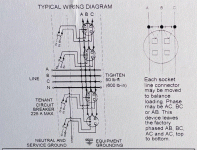I came across a new-to-me scenario that's aparently common for condo's and townhomes.
SoCal, SDGE, 208/3 ph service to an 800a switchgear that goes to a 4 gang meter pack. EZM314225 (pic of label attached) if that makes a difference. There are (4) utility meters, each with a 150a breaker at the meter, feeding a main lug only panel for each unit. Each subpanel at the units get (2) lines + a neutral, for 208 single phase service. AB or AC or BC
I've read that most appliances are able to run on 208/1 ph, and it's typically not that big of a deal.
However, when trying to install solar, the standard residential inverters run on 240/1 ph. Let's say that you were forced to install a standard residential inverter, how would that be accomplished?
The only thing that I could think of is to put a step up transformer in the garage, upstream of the unit's main panel (between the 150a breaker near the utility meter and the main lug only panel). I'd need to install a main breaker in the MLO subpanel so that there is protection on both sides of the transformer, and this would provide 240v service to the residence. In that scenario, once the transformer was installed it would be no different than any other residential install.
Am I missing anything? I found a quote for a single phase step up transformer, 45 kva for $5,000. I'd hopefully like to find a more affordable solution.

SoCal, SDGE, 208/3 ph service to an 800a switchgear that goes to a 4 gang meter pack. EZM314225 (pic of label attached) if that makes a difference. There are (4) utility meters, each with a 150a breaker at the meter, feeding a main lug only panel for each unit. Each subpanel at the units get (2) lines + a neutral, for 208 single phase service. AB or AC or BC
I've read that most appliances are able to run on 208/1 ph, and it's typically not that big of a deal.
However, when trying to install solar, the standard residential inverters run on 240/1 ph. Let's say that you were forced to install a standard residential inverter, how would that be accomplished?
The only thing that I could think of is to put a step up transformer in the garage, upstream of the unit's main panel (between the 150a breaker near the utility meter and the main lug only panel). I'd need to install a main breaker in the MLO subpanel so that there is protection on both sides of the transformer, and this would provide 240v service to the residence. In that scenario, once the transformer was installed it would be no different than any other residential install.
Am I missing anything? I found a quote for a single phase step up transformer, 45 kva for $5,000. I'd hopefully like to find a more affordable solution.


